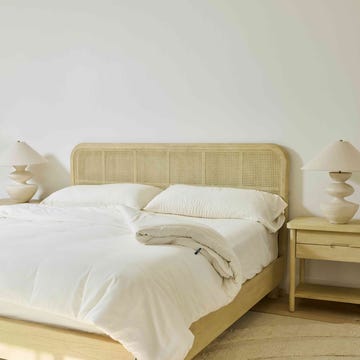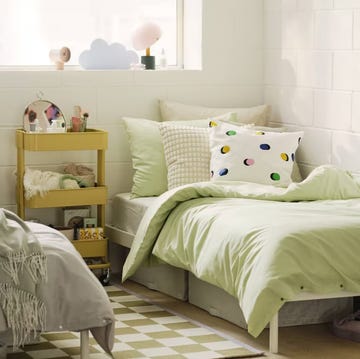You know that scuffed-up oak coffee table, battered bookcase or old-as-dirt desk you’ve been telling yourself — almost convincingly — just has a rich patina? Now’s a great time to admit that piece could really do with a refresh, because Furniture Clinic, a brand much beloved by DIYers and restoration pros alike, has just earned the prestigious Good Housekeeping Seal for its wood stains and wood varnishes. We’ll walk you through what the honor means and how the products work. (Short answer: reliably and beautifully.)
Why Is the Seal a Big Deal?
The Good Housekeeping Institute, which evaluates products applying for the Seal, has a crack team of scientists, engineers, chemists and analysts who scrutinize and rigorously test every potential recipient. That means consumers can feel confident that a product backed by the Good Housekeeping Seal will do what it promises to do — in the case of Furniture Clinic Varnishes and Stains, restore your wood furniture and protect it from future damage. And if a product with the Seal turns out to be defective within two years of purchase, Good Housekeeping will either replace it or refund the purchase price. So we’re financially on the line when we decide to stand behind a product — a pretty powerful endorsement.
Why Did Furniture Clinic’s Stains and Varnishes Receive the Seal?
Well, let’s ask one of those expert evaluators, Noah Pinsonnault, a product reviews analyst in the Good Housekeeping Institute’s Home Care & Cleaning Lab, who headed up the testing on Furniture Clinic Wood Stains and Varnishes. First up was the stain, which Noah applied to a worn hardwood chair. “I followed the instructions exactly and evaluated them for accuracy, clarity and thoroughness,” Noah says. “If it claims to color evenly and dry quicly, it has to live up to that in our tests.” Simple as that.
No spoilers here (since we already know the outcome) but suffice to say that the wood stain did indeed restore color “significantly” and provide “a new, more lustrous finish,” Noah reports. To verify Furniture Clinic’s claim that its stains are low-odor, Noah applied the stain in a small room — about half the size of a typical one-car garage—and came back 10 minutes later to check for lingering odors. “Not a whiff,” he says.
Next was the Furniture Clinic Wood Varnish. Same story as with the stain in terms of detectable odor — no trace. And to test the protection it provided, a pipette was used to place water droplets on the treated area. The water beaded up and did not soak into the surface, indicating a resistance to water-based spills.
So What Are We Waiting For? Let’s Stain Something
Furniture Clinic Wood Stains are water-based and come in 12 colors, all of which can cover your chosen restoration-project piece evenly in just one coat and dry quickly—in about 10 minutes. (More about the various shades in a minute.)
To use it successfully, first prep the wood. If your furniture is coated with old paint or varnish, remove it, then sand it all over to create a smooth surface for the stain to absorb into. Wipe the wood down afterward to make sure it’s completely free of sawdust and any dirt.
Then, using a foam brush or a lint-free cloth, apply the stain generously, going in the direction of the wood grain, and leave it to soak in for a minute or two. The longer you leave it on, the deeper and richer the final color will be. (The company recommends staying on the safe side by waiting only one or two minutes; if it dries too light for your taste, you can apply another coat. Going too dark is much harder to fix — you’ll have to break out the sandpaper again.)
Now use a lint-free cloth to wipe off any excess stain and wait about 10 minutes for everything to thoroughly dry. (This is when you would apply a second coat to darken further, if you choose.)
The Finishing Touch: Varnish
Varnish not only enhances the stain you’ve just applied, bringing out even more of the wood’s grain and color, it also acts as a shield against coffee spills, dropped keys, vacuum-cleaner collisions — all the little mishaps that got your furniture to its worn-and-torn look in the first place.
Furniture Clinic Wood Varnishes come in three finishes: matte, satin and gloss. As with the stain, you’ll first wipe your piece down to make sure it’s dust- and grit-free. (It should also be completely dry from the stain, of course — but given that product’s super-fast drying time, that’s not a big deal.) Apply the varnish with a foam brush and leave it to dry for an hour. Do a light sanding, then apply another coat, and repeat the same process one final time for a very tough, durable coating.
Decision Time! Choose Your Stain Color and Finish
Now that you see how easy it is to use Furniture Clinic’s products — and how reliably they give a glow-up to tired wood — it’s time to plan your project. To get you thinking creatively, we’ve come up with a few ideas for choosing which color and finish to go with.
•For a rich, moody, British period-film sort of look: Dark Oak, Mahogany, Walnut or Rosewood stain + Gloss or Satin varnish.
•For a breezy, casual midcentury-modern effect: Teak, Black or White Ash stain + Matte varnish
•For a high-impact, urban-contemporary aesthetic: Walnut, Black, Warm Graphite or Slate stain + Gloss or Satin varnish
•For a modern farmhouse vibe: Natural Oak, Antique Pine or Grey stain + Satin or Matte varnish
Of course, these are just a few of the many possibilities. All of the dozen stain colors will bring new life to old furniture (or floors, doors, wood trim...). And every one of the three varnish options will go the distance in protecting your piece from dings and disrespect, no matter which one you, um, take a shine to. But a quick caution: You're going to want to refurbish everything in sight!

















